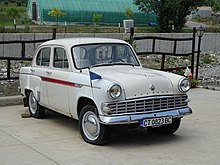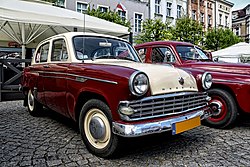Moskvich-403
| Moskvich | |
|---|---|
|
Restored Moskvich-403E, photographed 2015
|
|
| Moskvich-403 | |
| Sales designation: | Москвич-403 Москвич-424 Москвич-432 |
| Production period: | 1962-1965 1963-1965 / 67 |
| Class : | Lower middle class |
| Body versions : | Limousine , station wagon , panel van |
| Engines: |
Otto engine : 1.4 liters (33–37 kW) |
| Length: | 4055 mm |
| Width: | 1540 mm |
| Height: | 1560 mm |
| Wheelbase : | 2370 mm |
| Empty weight : | 980-1030 kg |
| Previous model | Moskvich-407 |
| successor | Moskvich-408 |
The Moskvich-403 ( russian Москвич-403 ) is a passenger of the Soviet manufacturer Moskovsky Zavod Malolitraschnych Awtomobilej (Russian Московский завод малолитражных автомобилей shortly MZMA or МЗМА Russian, known by the use of the brand name Moskvich ), who built from 1962 to 1965 in series has been. It is the successor to the Moskvich-407 and has already largely received the newly developed landing gear parts of its successor, the Moskvich-408. The body shape remained almost unchanged.
Under the name Moskvich-424 (Russian Москвич-424) a version was built as a station wagon, the Moskvich-432 is a closed box van. Both were built from 1963 to at least 1965, according to other sources until 1967 and thus two years longer than the sedan.
Vehicle history

From 1959 a successor to the Moskvich-402 was planned in the Moskvich plant . It was introduced as the Moskvich-408 in 1964. However, various parts of the development, such as the front suspension, the braking system, the steering, the bulkhead and the subframe , which were later also used in the Moskvich-408, were available earlier. They were built into the Moskvich-402 and this is how the Moskvich-403 was created, which was manufactured in series from December 1962. Externally, almost nothing changed on the vehicle, at least in the basic version. Only the rear lights now looked different and had three chambers. There were also new emblems on the side that said 403 .
In addition to the basic version for the domestic market, an export version was built for the first time. Depending on the source, it was referred to as Moskvich-403E , Moskvich-403IE, or Moskvich 403 / IE . The most noticeable change is the larger, chrome-plated radiator grille, which is less rounded. But the side moldings were also arranged differently and the rear was slightly changed. The rear light lenses in particular are different from the basic version, but both lens types fit in the same bracket. The handle on the trunk lid has also been redesigned. There were also changes to the seats: one bench in the front remained. The backrests of the driver and front passenger cannot be adjusted individually, but can be folded down to make a bed. The seat covers were now made of synthetic leather. Further detail improvements included an improved front axle, a windscreen washer system (operated by foot), an improved gear lever and improved steering (three-part tie rod with intermediate lever).
In addition to the sedan, station wagons ( Moskvich-424 ) and panel vans ( Moskvich-432 ) were also manufactured from 1963 . There was also an export version of the station wagon.
A total of 105,723 Moskvich-403s of all versions were built up to July 1965. Other sources indicate that station wagons and panel vans were produced until 1967. The successor was the Moskvich-408 , which, with the exception of the parts already used in the Moskvich-403, was of a new design and its exterior was also significantly changed.
Model variants
Different versions of the Moskvich-403 were built; there were no prototypes based on this vehicle.
- Moskvich-403 - basic model with limousine body, built from December 1962 to 1965. Various sources indicate that from April 1964 a revised version of the four-cylinder engine with 50 HP (37 kW) was installed.
- Moskvich-403E - basic model with limousine body, for export. Deviatingly also called Moskvich-403IE .
- Moskvich-403Ju - basic model with limousine body, for export to countries with tropical climates.
- Moskvich-403B - Like the basic version, but all controls have been converted so that they are suitable for people with physical disabilities.
- Moskvich-403M - For transporting medical personnel and materials, for example to make home visits to patients.
- Moskvich-403T - model, specially equipped and painted as a taxi .
- Moskvich-424 - Version built from 1963 to 1965 (1967) as a four-door station wagon.
- Moskvich-424E - four-door station wagon for export.
- Moskvich-432 - Version built from 1963 to 1965 (1967) as a closed box van with only two doors.
- Moskvich-432E - export delivery van.
- Moskvich-432Ju - box van in export version , for the tropical climate zone.
Based on the Moskvich-432, the Luzki Maschinostroitelny Sawod (German Luzker Maschinenbauwerk) built the LuMZ-945 , a refrigerated truck with a payload of 170 kg, between 1964 and 1965 . It was designed for a temperature range of −6 to +5 ° C.
Technical specifications
For the Moskvich-403 sedan , if known.
- Engine: four-cylinder gasoline engine
- Engine type: MZMA-407
- Power: 45 HP (33 kW) at 4500 min -1 , later 50 hp (37 kW) at 4750 min -1
- Displacement: 1358 cm³
- Bore: 76.0 mm
- Stroke: 75.0 mm
- Compression: 7.0: 1
- Firing order: 1–3–4–2
- Torque 91.2 Nm at 2750 min -1
- Fuel: petrol with at least 72 octane
- Consumption: according to the standard 6.5 l / 100 km, practically 8 to 12 l / 100 km
- Tank capacity: 35 l
- Transmission: manual four-speed transmission with reverse gear
- Top speed: 115 km / h
- Acceleration: from 0 to 80 km / h in 18 s
- Starter: Type ST4, 0.6 HP power
- On-board voltage: 12 V.
- Drive formula : 4 × 2 (rear wheel drive)
measures and weight
- Length: 4055 mm
- Width: 1540 mm
- Height: 1560 mm
- Wheelbase: 2370 mm
- Front and rear track: 1220 mm
- Turning circle: 11 m
- Tire dimension: 5.60-15 ″
- Boot space: 340 l
- Empty weight: 980 kg (combination: 1030 kg)
- Payload for the combination version: 250 kg
- permissible total weight: 1280 kg
- Axle load: 640 kg front and rear
Test reports
In the KTA test , it was noted that the Moskvich-403 had gained, especially in terms of improved driving safety, and at the same time gave the impression of continuing to have the great robustness of its predecessor. The large ground clearance is also suitable for rough terrain. The very effective heating and ventilation system, as well as the smooth-running and soft-acting clutch, as well as the well-translated, smooth-running steering, which hardly transmitted any bumps into the steering wheel, were praised. The brakes also responded very softly, but required excessive pedal force to brake sharply. The improved front axle resulted in a lower curve inclination, which was more pronounced in the 407. Criticism was directed at the engine, which could not be satisfactory in terms of performance or fuel consumption. The gearbox was also criticized, the synchronization of which did not work sufficiently effectively and which caused excessive noise, especially when overrun. Furthermore, the windshield wipers were criticized, which still worked according to the counter-rotation principle and dependent on the engine speed. The design changes compared to type 407 were rated as not beneficial. The average consumption was measured at 9.5 l / 100 km, and the maximum speed was stopped at 109 km / h, contrary to the factory specification. The KFT added in a travel report that the long suspension travel and soft padding would offer the benches great ride comfort, but the interior noise at higher speeds to be high. Despite the improved front axle, the Moskvich still requires a moderate driving style, since the rear axle tends to deviate from lane and break away. The top speed was 113 km / h, the fuel consumption 12 l / 100 km.
literature
- LM Shugurov: АВТОМОБИЛИ. России и СССР. Second part. Ilbi / Prostreks, Moscow 1994, ISBN 5-87483-006-5 .
- Ministry of Automobile Transport of the RSFSR ; Vehicle Construction Institute NIIAT: Short Automobile Manual (краткий автомобильный справочник). Transport Publishing House, 6th edition, Moscow 1971.
Individual evidence
- ↑ a b c d e L. M. Shugurow: АВТОМОБИЛИ. России и СССР. Second part, p. 34.
- ↑ a b Information on the basic version Moskvich-403 on denisoviet.ru (Russian)
- ↑ Information on the Moskvich-403E on denisoviet.ru (Russian)
- ↑ a b Information on the Moskvich-403IE from the car magazine "За рулем" (Russian)
- ↑ Test: Moskvich 403 / IE. In: Automotive Technology . 5/1964, pp. 185-187.
- ↑ Test: Moskvich 403 / IE. In: Automotive Technology . 5/1964, pp. 185-187.
- ↑ a b Overview of all vehicles manufactured by Moskvich as well as further information on the individual types on denisovets.ru (Russian)
- ↑ a b c Information on the Moskvich-403 in the car magazine "За рулем" (Russian)
- ^ Ministry of Automobile Transport of the RSFSR ; Vehicle Construction Institute NIIAT: Short Automobile Manual (краткий автомобильный справочник). P. 279 f.
- ^ Ministry of Automobile Transport of the RSFSR ; Vehicle Construction Institute NIIAT: Short Automobile Manual (краткий автомобильный справочник). P. 38 ff.
- ↑ Test: Moskvich 403 / IE. In: Automotive Technology . 5/1964, pp. 185-187.
- ^ Motor vehicle technology drove Moskvich 403. In: Motor vehicle technology . 5/1964, p. 188.




